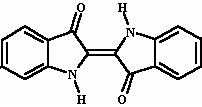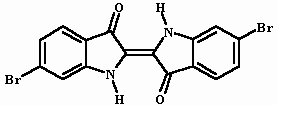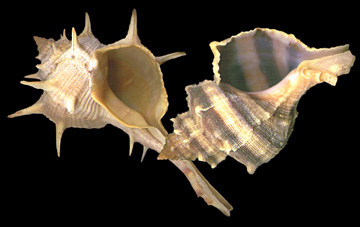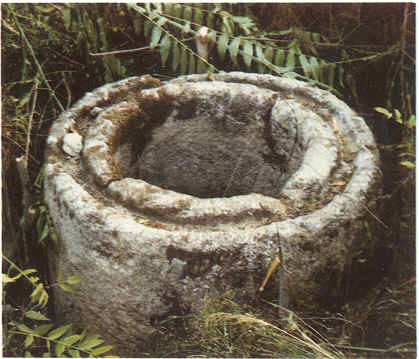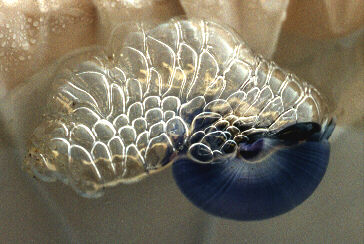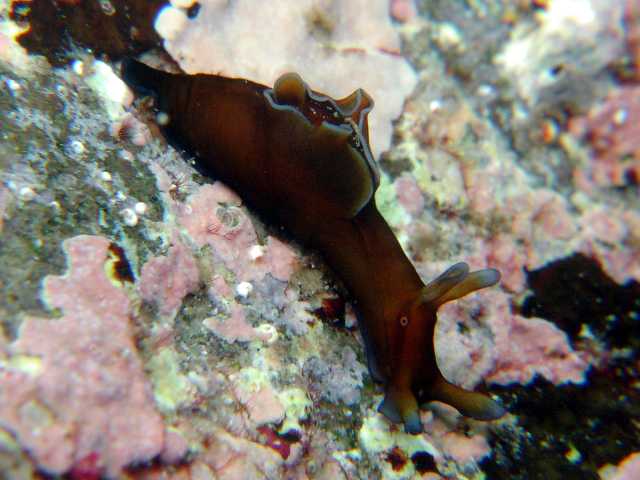К оглавлению
Levi Kitrossky
Do We Know Tekhelet?
To the memory of my father-in-law.
Preface
The principal objective of this article is to address the problem of a possible Tekhelet revival in our times. The subject itself is thrilling enough and reflects progress in chemistry, physics, history as well as Jewish traditional law (Halacha) studies. The story also provides one more example of mutually beneficial interaction between religion and science.
A brief review of dyeing techniques in ancient times../../images/hist/tekhelet../../images/hist/tekhelet
Dyes in ancient times../../images/hist/tekhelet../../images/hist/tekhelet
Dyes are colored substances that make strong physico-chemical bonds to materials, resulting in colored materials, mainly textile. There are thousands of synthetic dyes now but in the ancient times there were about thirty dyes, all of vegetable or animal origin.
Most of them, such as Saffron, Indigo, and others, are well known.
|
|
Figure 1. Crocus (Saffron): used as a source for the orange-yellow saffron dye (now only in artistic paints). Photo: Prof. L.J. Musselman. |
Figure 2. Indigo plantation in Thailand: used as a source for the dye of the same name |
The Torah mentions three dyes: Tekhelet (blue), Argaman (purple),and Tola’at shani (scarlet), used in materials for the Tabernacle1 and garments of the High Priest2. Tekhelet is also prescribed for a thread in tzitzit 3. All the three are difficult to identify. In the case of argaman and tola’at shani, the obstacle is rather natural, as these dyes have not been in ritual use since the destruction of the Second Temple; the same happened to the sacral spices of the Temple (“Ketoret”). The disappearance of Tekhelet, which was still in use during another several hundred years and is well described in the Talmud 4, is more surprising, especially in the light of the importance of the tzitzit commandment. A rich traditional bibliography can be found in 5.
The only comparable case is the disappearance of the Tyrian Purple. This is one of the most famous dyes. Its detailed descriptions are provided by Pliny the Elder, Vitruvius, Chaucer, and it is mentioned by other ancient and medieval authors. Its discovery is narrated in the Greek mythology, and its Greek name “phoenix” (Phoenicia being its country of origin) was also given to the mythological bird.Most scholars also link name "Canaan" to (reddish) purple.
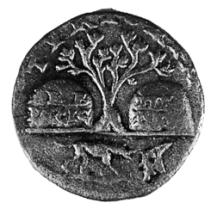
The dye was of great value, and, during some periods, its use was limited to royal garments only, hence its other name of Royal Purple. Its secret lasted longer in the East, where it came from, and is believed to be lost after the fall of Constantinople in 1453.
The scientific progress
Let us see if science can be of use in the search of Tekhelet. In the following subsections, the reader may ask, what it is all for. For those who can bear with some history of science, the answer will be there as we proceed toward the end; those who positively cannot may jump to the section “Attempts to rediscover Tekhelet.”
Chemistry ../../images/hist/tekhelet../../images/hist/tekhelet
In the 18th century, chemistry emerged as a scientific discipline. While synthetic compounds were rare, the first artificial dye – the Prussian Blue – was invented as early as in 1774. From school lessons in inorganic chemistry, some may recall the phenomenon of intensive blue precipitation as a result of a reaction involving two iron compounds. It is that one.
New elements were discovered one after another; an important finding was Bromine (from the Greek for “stinking”), obtained from seawater. It has been extracted from there up to this day and is nearly the only Israeli mineral resource.
Artificial organic dyes were still to come; when Napoleon announced a one million franc award for artificial indigo, nobody was able to claim the prize. The natural product was unavailable because of the war with Britain.
Organic synthetic dyes began to appear in 1856; the first ones were Mauve, Fuchsin, Magenta. Jews have always been interested in dyeing , as one can infer from such surnames as Farber, Himmelfarb, Krasilschik, so it comes as no surprise that one of the first inventors of an organic synthetic dye was a Jew from Poland Yakov Nathanson (1832-1884. The patriotic history books in the USSR call him the first, whereas most sources outside Russia ascribe the priority to Sir H. W. Perkin of England).
The same man also synthesized the natural dye Alizarin (madder) but this had already been accomplished by two Germans (Graebe and Liebermann) in 1868. It was the first time that a natural dye was obtained artificially.
In 1878, Adolf von Baeyer of Germany succeeds in synthesis of indigo after 15 years (!) of work. Finally, Paul Friedlander, also of Germany, proved by chemical analysis that the Tyrian purple is a close relative of indigo, identified as dibromoindigo. These findings proved that natural source of Tyrian purple must be from sea, because only sea contains bromine
A sea of success, but what about Tekhelet?
Physics and Physical Chemistry../../images/hist/tekhelet../../images/hist/tekhelet
We shall only touch upon the theory of color and its generation/simulation. Everybody knows the spectral colors and the glass prism. But there are some enigmatic properties in color. Let us ask: why do yellow and blue make green? No spectra can account for this. There were a lot of unsuccessful attempts to explain this kind of phenomena, e.g. one by der groЯe Deutsche Dichter J. W. Goethe.
Finally, it turned out that there are only three types of color sensitive cells in the eye. This means that visual images of colors constitute a 3-dimensional space, in which every visible color is represented as a mixture of the three basic colors taken in a certain proportion. A similar representation (the RGB system) is used in color monitors/printers. Furthermore, every color can be represented in two ways – additive and subtractive. Say, yellow can be represented by the spectral yellow and also as white minus blue. The eye gets the same impression, despite the fact that the spectra are very different. It can readily be understood that a dye works in the subtractive way, absorbing a part of the spectrum and thus having the cloth appear colored. So, to make a dye one needs to look for substances that absorb some spectral components of visible light. According to the electronic theory of color in dyes, the following factors make a color deeper: the length of the molecule, alternating regular and double chemical bonds (conjugation), inclusion of atoms other than those of carbon, hydrogen and oxygen. All this explains why the color of the Tyrian purple is deeper than that of indigo. As one can see, the only difference between the structures in figures 4 and 5 is two bromine atoms.
|
|
Figure 4 The structure of indigo |
Figure 5 The structure of the Tyrian purple dye |
History and archeology
An important discovery was made by Bartolomeo Bizio in 1832 and Henri Lacaze-Duthiers in 1958. Together they rediscover the Tyrian purple! The former just experimented with mollusks of the Murex genus (“purple-fish”). The latter, while on a scientific trip in the Mediterranean Sea, saw a sailor make stripes on his undershirt with a colorless fluid pressed out of a mollusk, and the stripes turned purple-blue by themselves! In some sources, the discovery is attributed to William Cole, dating as early as 1684.../../images/hist/tekhelet../../images/hist/tekhelet
|
Figure 6 Murex branfaris and Murex trunculus. Courtesy of Paul Monfils, Ph.D. |
In the modern industry, this kind of coloring is called vat dyeing. Its explanation is fairly simple. Many good stable dyes are insoluble in water and cannot directly be used for dyeing. However, it is possible to perform the so-called reaction of reduction, which renders the dye colorless but soluble. The cloth is put into the vat (“Yora” in Hebrew, which means just a kind of a big tub) to absorb the reduced dye and then taken out to dry in the air. The oxygen transforms the dye back to its insoluble but colored form. The usual jeans are colored this way by indigo.

In the case of the Murex, one can do without a vat process, since the mollusk's
"juice" contains colorless soluble substances ("indigoid precursors"),
which, in the air, soon turn into indigoid. So, one can put the precursor on the fabric
and wait until the precursor turns into indigoid and dyes the fabric.
Archeologists found a lot of sites with ancient dye plants. Many of them are in northern
Israel near the Mediterranean Sea. The
plants are full of seashells and remains of pigment, in quantities sufficient for chemical
analysis.
|
Figure 8 from5. An ancient dye plant. Photo: Yosef Kali. |
All this may be interesting but what about Tekhelet? One cannot demand still more patience from the reader, so let us turn to Tekhelet proper.
Attempts to rediscover Tekhelet
In an attempt to rediscover Tekhelet, one must stick to the following program14.
1. Make sure that the species, which is a potential source of the dye, is not extinct../../images/hist/tekhelet../../images/hist/tekhelet
2. Make reasonably sure that we know all Mediterranean species that can be found off the Israeli coast. ../../images/hist/tekhelet../../images/hist/tekhelet
3. Find a group of existing species that can be used for dyeing../../images/hist/tekhelet../../images/hist/tekhelet
4. Choose the species that is the closest to the “Hilazon” creature, a sea animal described in the Talmud and Law codes as the source of Tekhelet.../../images/hist/tekhelet../../images/hist/tekhelet
Let us review such attempts
Rav Gershon Hanoch Leiner (Radzyner Rebbe)
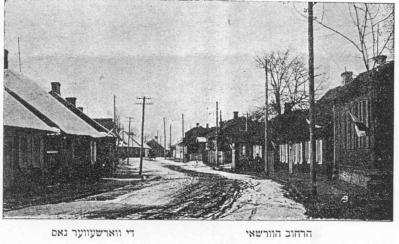 |
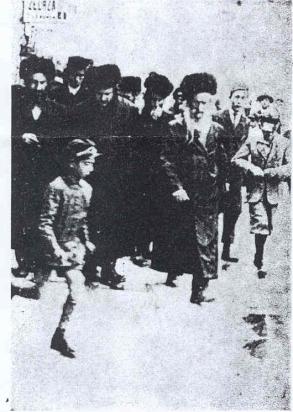 |
| Fig. 9.An old archive photo of Radzyn: Warsaw street.Radzyn, near Kock and Lublin | Fig. 10. An archive photo: Radzyner Hassids with Rebbe Shmuel Shlomo Leiner (second from the left) before the Holocaust. The last Rebbe of the dynasty and the last in his town. Courtesy of Dr. Asaf Kaniel. |
R. Gershon Hanoch Leiner (1839-1891), the Radzyner Rebbe, is almost a legendary figure, reported to be a polymath well versed in chemistry, languages (including even Arabic), a good horse rider etc. In his book, he makes free use of scientific advancements and refers to Aristotle and Darwin. Of course, all this is in addition to Judaism studies. He set the goal of recovering Tekhelet and wrote three books on the issue. After consultations with experts in both Talmud and science and an investigation of his own (mainly in the Naples maritime museum), the Rabbi declared in 1888 that the creature, the substance, and the method had been found! About a thousand and a half year gap had been filled! A relative of the squid, called cuttlefish (ink fish), produces the ink-like substance sepia at the moment of danger, and from this substance the dye can be extracted. The works of the Radzyner Rebbe stimulated a lot of people to wear Tekhelet, most of them being naturally Radzyner Hassidim. The color of the Radzyner Tekhelet is very deep dark blue. Leiner’s dynasty was cut short by the Holocaust but production of Tekhelet continued for more than 100 years. Details of the procedure developed by the Rebbe were lost during the Holocaust but restored in Israel.
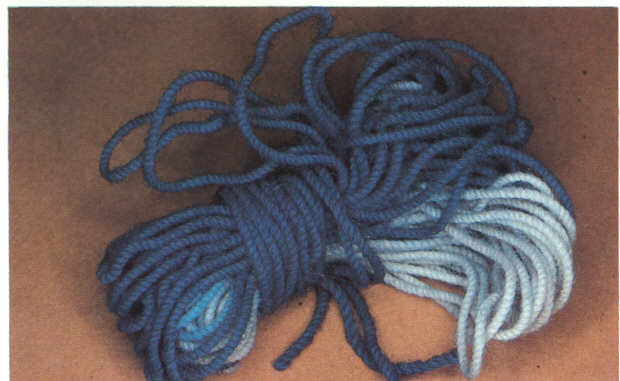 |
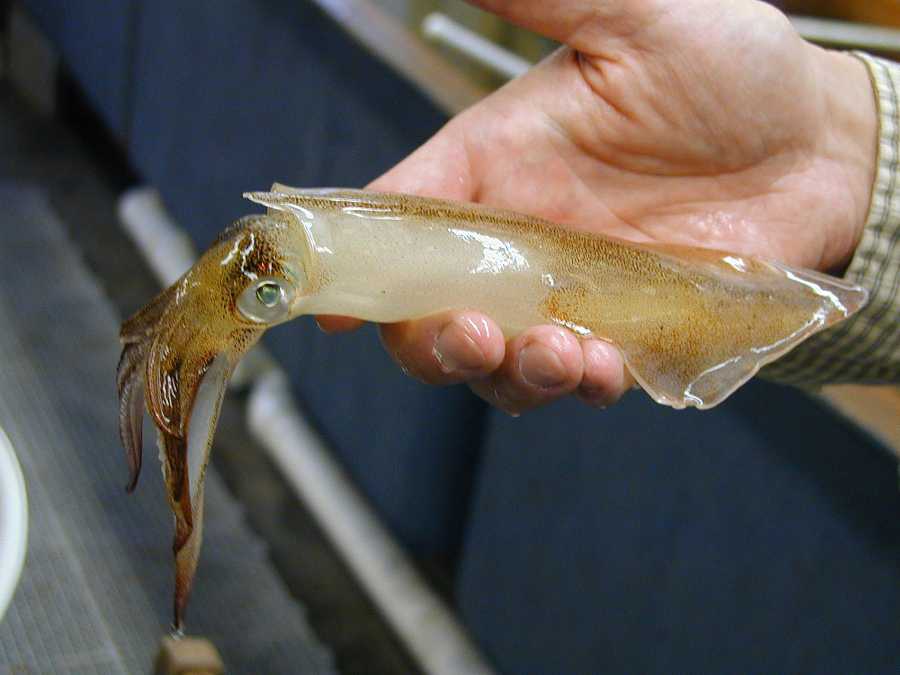 |
Figure 11. Tekhelet of Radzyn . Photo: David Darom. |
Fig. 12. Ink fish. Courtesy of Elaine L. Bearer, Lucas Pozzo-Miller, Joseph A. and DeGiorgis. |
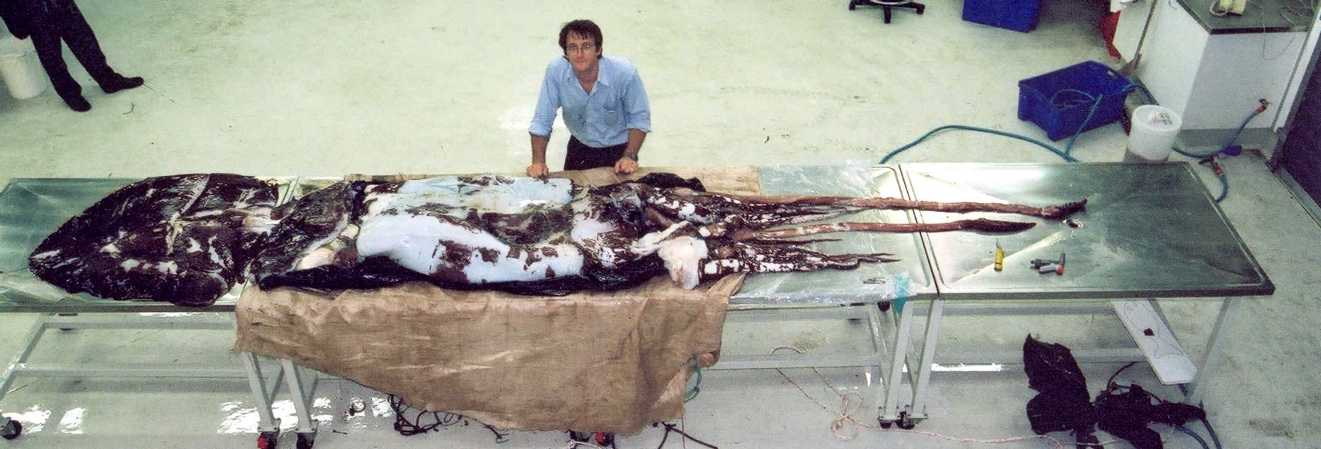 |
|
Fig. 13. The leading specialist in cephalopods Dr. Steve O’Shea with 5m predator colossal squid. Captured on April 3, 2003 by fishermen in the Ross Sea in Antarctica. Some species of squid family can reach 13m. Occasionally attack ships, humans. Reprinted by permission |
|
It seems that the Rebbe was fascinated by the cuttlefish, which is very understandable. This creature of the cephalopods (“legs in head”) class has 10 “legs” (the decapods order), which suddenly spring toward its prey, starting with the two longest ones. It uses reactive force to jump under and out of water. If attacked, it issues ink decoys, which explode into ink clouds and thus disorient the enemy. It has eyes not worse than people’s!
Strong sides of the ink fish theory../../images/hist/tekhelet../../images/hist/tekhelet
The greatest importance of the discovery was in its effect on Jewish
life. People awoke from drowsiness and start asking: why can we not restore Tekhelet,
then argaman, ketoret – and maybe the Temple itself, the ultimate goal? The
Rebbe was very energetic in all his undertakings. The following anecdote illustrates his
character. He was asked, why he did not act like his father, who always avoided
confrontations. The answer was: I do act like my father, because he did not act like his
father!
In spite of the initial skepticism of the scientists, the Rebbe managed to produce a blue
dye from a sea animal, and the main criteria are that the dye produced should be fast,
beautiful, and obtained from a sea animal.
Some of the Talmud criteria are met in the ink fish. It hides in sand and has blue blood,
unlike
regular fish. (The blue color results from its blood being copper-based, unlike the
vertebra's blood, which contains hemoglobin and is iron-based.)
Weak sides of the squid theory../../images/hist/tekhelet../../images/hist/tekhelet
It turns out that one can make the same color even without sepia! During the procedure, the organic substance is strongly heated. It causes decomposition with almost total loss of carbon; the only remaining holders of carbon are cyanic groups, which can also be obtained from other proteins. For example, ox blood was used for this purpose already in the 18th century. The dye is thus almost outside the realm of organic chemistry (although it is not critically important, since the border between organic and inorganic chemicals is not always clear.)
Some sources seemingly speak of
the Hilazon as of an animal with a shell . E.g., the Hilazon is said to grow
together with its sheath (nartik), clothes (malbush); one can crack it (poz’o).
At least in one place (Sanhedrin 91A), the Talmud apparently uses word the Hilazon
as is in modern Hebrew – just “snail” without a connection to Tekhelet:
“after rains all the hill is full of Hilazons”. However, one can
defend the cuttlefish candidacy referring to a rudimentary shell that it has under its
skin.
Furthermore, the Talmud says that the Hilazon is very rare, which can hardly
apply to the cuttlefish.
Another weakness is that the color itself poorly corresponds to the sky blue color
described in Talmud. However, one must be cautious when interpreting the ancient color
adjectives, as words keep changing their narrow meaning. Supporters of the theory may try
to improve the procedure in order to arrive at a brighter color. Although there seems to
be a psychological problem for a Hassid to attempt an improvement of the work of his
Rebbe, yet some people wrote of their willingness to amend the process. Of course, other
squid species can also be used.
Rav Yitzhak Herzog Halevi (1888-1959)
Rabbi Herzog completed his Ph. D. thesis6 on Tekhelet in England in 1914. Most of his work is translated by Rav Burshtin5. Rav Herzog found the Radzyn Tekhelet too dark. He also discussed the possibility that Tekhelet was somehow connected to the Tyrian purple, whose rediscovery had been firmly established. Some scientists, e.g. A. Dedekind, hypothesized already in the 19th century that the Tyrian purple and Tekhelet were relatives. But the Murex snails, which were used for the Tyrian purple, did not produce sky blue, so the possibility of the Murex being Hilazon and the source of Tekhelet was rejected. As a result of his research, Rav Herzog proposed another species, Janthina (sgulit), of the gastropods type (“legs from belly”). It has a blue body, keeps itself on the surface with glued air bubbles, and sometimes releases a blue substance. However, there was a problem with this candidate, too – it failed to yield a fast color.
Another interesting turn of the story occurred when Rav Herzog studied the Radzyner Tekhelet. Following the request of P. Friedlander, Rav Herzog sent him samples of the Tekhelet of Radzyn. Friedlander, who determined the structure of the Tyrian purple, was eager to see what the newly introduced dye was. To Rav Herzog’s surprise, it turned out to be the essentially inorganic dye Prussian Blue, known from 1774! Several important chemists declared with all scientific authority that this substance could not be obtained from an animal source. But as time passed, it turned out that the greatest specialists in dyeing had been mistaken! The Radzyn process involved a complex thermal disintegration decomposition of sepia, which produced poisonous cyanic groups CN. During the process, iron compounds are added that tie the CN groups into the so-called complex or coordinate anion ferrocyanide [Fe(CN)6]3-. Addition of more iron results in the reaction: 2[Fe(CN)6]3-+3Fe2+ = Fe3[Fe(CN)6]. The latter substance precipitates in dark blue wet powder and is called Prussian Blue.../../images/hist/tekhelet../../images/hist/tekhelet
Last year (2002), the Janthina theory suddenly received a boost: Dr. S. W. Kaplan, a biologist from Rehovot, claimed that he had managed to dye wool in a fast beautiful blue color by boiling wool and the dye in water together with a mordant15. Dr. Kaplan called the color Royal Blue, because of its beauty. These lines might be the first publication of these findings in English, a real journalistic scoop for our edition! We collected reliable evidence that the dyeing is real; the color is bright blue and endures machine washing. Some say, however, that the color somewhat fades with time. On the Web page15, there are also references to archeological research that resulted in finding Janthina snails in the ancient sites. Preliminary data21, 22 on pigment in Janthina point out to the substance called aplysioviolin, containing zinc. It is one of the so-called arylmethane-dyes, which are usually light sensitive; this could possibly explain the fading of the color.
|
|
| Figure 14. Janthina15. It floats with the aid of bubbles glued by a special secretion.Photo: S.W.Kaplan, Ph.D. | Fig. 15.The Aplysia ( “sea hare”). Another candidate for the Hilazon? Photograph and copyright 2003: Jun Imamoto. Reproduced with permission. |
If aplysiviolin was successfully used for dyeing, one can also think of the Aplysia (fig. 18), which, too, yields a violet liquid. It was mentioned by R. Tavger in ref.14 but he was then told by specialists that the Applysia’s secretion could not be used for dyeing. If we insist on a shell for the Hilazon, the Aplysia has a miniature relict shell on its back (cf. the cuttlefish "shell" mentioned above), but the shell is too small to be detected in archeological findings.
Strong sides of Janthina theory
This gastropod is a passive predator; it floats freely in warm water waiting for prey to come. It has a marine blue color for mimicry and sometimes gathers into small floating islands. On rare occasions, such islands are thrown by wind onto beaches, dyeing them blue. All this is fairly close to the Talmud indications.
Weak sides of Janthina theory
The theory is very promising; we also found some other sources describing the purple pigment of Janthina19. However, the fastness of the dye cannot yet be deemed proven; the results have not been published in a scientific journal. The chemical properties of this blue excretion seem still unexplored.
I.I.Ziderman, Rav Tavger and prof. Elsner
By 1980, there appeared a number of specialists in ancient dyeing, who were sure that Tekhelet and the Tyrian purple were the same. Among them were Israeli scientists who tried to prove it. I.I.Ziderman7 developed theory that different species of Murex give more reddish and more bluish color. The latter could be Argaman and the latter Tekhelet, according to Dr. Ziderman. This bluish color had been obtained as early as 1832 by Bizio. The greatest problem was the color – not blue enough. In 1985, prof. Otto Elsner, a specialist in dyes, together with marine zoologist Ehud Spanier, found the the color depends on sex of mollusks. Later they published breathtaking news: they succeeded obtaining a blue color dye from the species Murex trunculus (Argamon kehe-kutzim)!
The main result was that the dyeing in intensive sunlight resulted in blue, whereas the dyeing during a moderately bright day or in a room resulted in purple. These results were in essence printed in German already in 1944 by Driessen23. After some investigation, it turned out that a photochemical process was involved that results in a partial loss of bromine atoms. ../../images/hist/tekhelet../../images/hist/tekheletA mixture of dibromo-, monobromo-, and plain indigo emerges, as shown by Prof. Zvi Koren12. The loss of bromine makes the color of the dye less deep, as the theory predicts, and it turns out to be blue rather than purple. The processes in secretions of mollusks are not simple, though. The percentage of bromine appears to depend on the snail’s sex, and it varies during the life of the mollusk, as was discovered by Elsner and Spanier. The fraction of bromine and so the color to be yielded also depends on the exact species in the family.
Another important character of the story is Rav Eliahu Tavger. He is the one who produced the first tzitzit dyed by snails from northern Israeli beaches and proclaimed them to be valid from the point of view of the Jewish law. (Interestingly, the late father of Rav Eliahu prof. Benzion Tavger restored the “Avraam Avinu” synagogue in Hebron, basically single-handed).
There are two ways of dyeing Murex dyeing technique can be implemented in two ways – from fresh snails, using natural indigo precursors, or from a dry extract. The former is not practical in big quantities, while the latter requires the vat process. The vat dyeing has been run smoothly enough for several years but it employs some modern chemicals, the favorite one being sodium dithionite Na2S2O4. The fact that no such things could be used by the ancient renders the idea somewhat doubtful.
Then, in 1995, Dr. Cardon found and translated a 1418 Florentine recipe for a vat process that used an indigoid plant called woad. This technique involved fermentation. During the process, leaves were put in hot alkaline water for a while, and then the resulting liquid became capable of reducing indigo. Research showed that in these conditions, a bacteria of Clostridium family developed, and the process was not purely chemical but rather microbiological16,17. The foundation “P'til Tekhelet” learned about the breakthrough and sent the dry extract of snails to several people, asking to repeat the process. One of them was John Edmonds of England, a retired engineer who had been interested in ancient dyeing for years; another was Prof. Zvi Koren at the Shenkar College in Israel. Mr. Edmonds found that woad fermentation was not good, since it brings its own indigo in and obscures the results. So, he turned to fermentation from cockles’ meat, as he was short on the Murex. In 2000, it was finally clear that Mr. Edmonds succeeded not only in dyeing but also in restoration of the process described by Pliny the Elder. It also turned out that what Pliny described was not only dyeing but also fermentation and reduction of indigoids into a yellow solution of leuco-base 9. The conditions of the process – alkaline, heat, and high amounts of salt – enable the growth of the desired bacteria while preventing the growth of others. In that same year, Prof. Koren succeeded in developing a completely natural dyeing method, using an all-murex system for both the reduction and the dyeing stages, which also made the dye production highly efficient18.
Wool put in this yellow leuco-solution absorbs the chemical; when taken out into the air, it turns purple or blue, depending on the intensity of light and other factors, as originally shown by the late Prof. Elsner.
Let us take a look at the following photographs from the Internet photo gallery10.
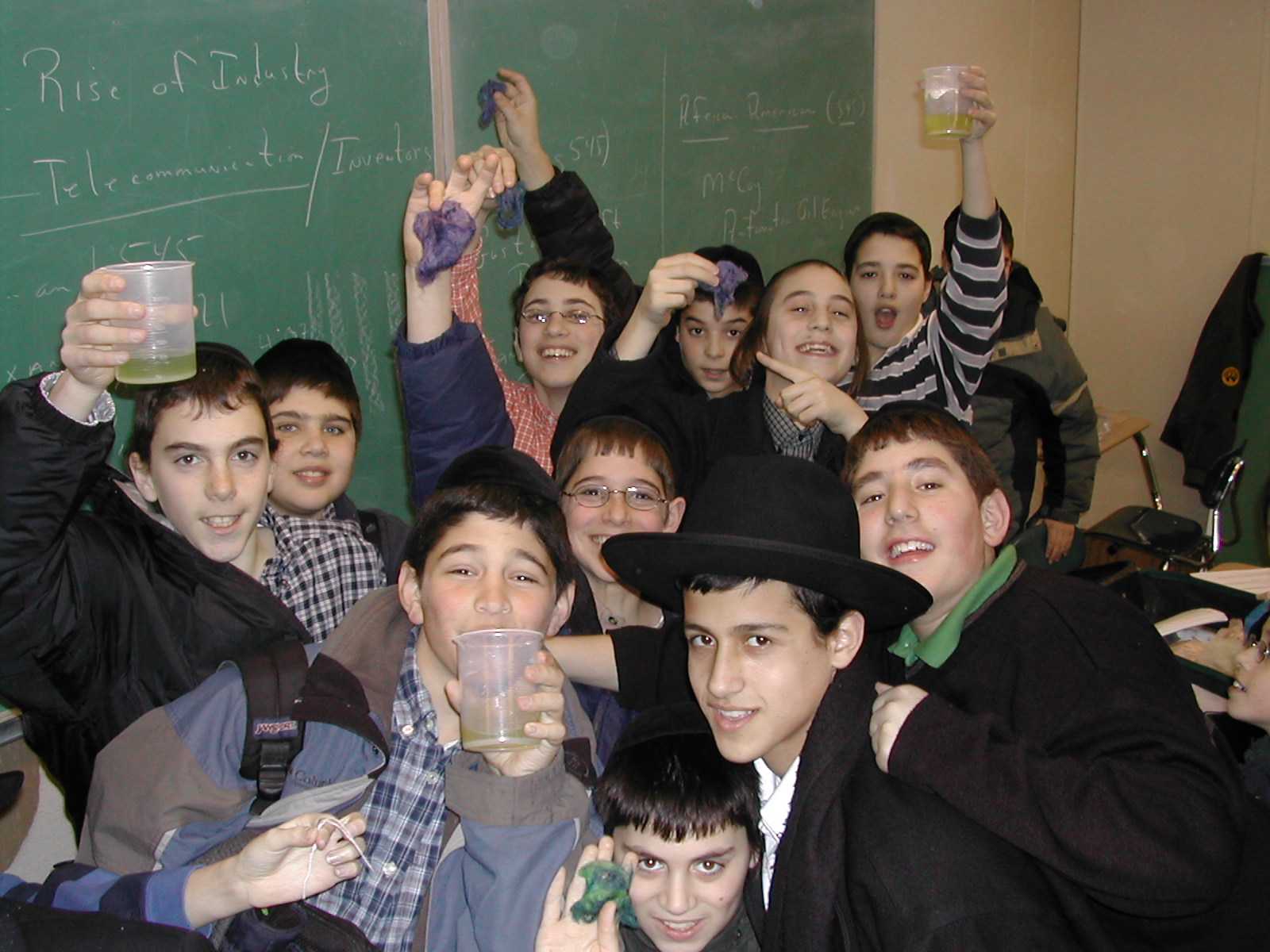 |
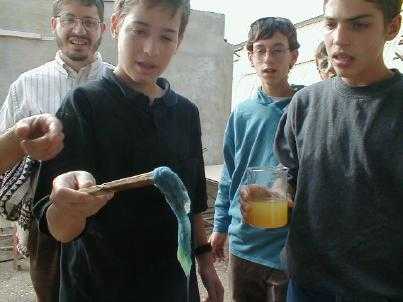 |
Fig. 16. Yeshiva in Far Rockaway, NY |
Fig. 17. Yeshiva “Mekor Chaim”, Israel |
In both of them, we can see the yellow solution of leuco-base. Wool has been put in and taken out. In the left picture, we see how the color first turns green (as a mixture of purple and yellow) in the hands of the boy in the foreground. Then it turns purple in the hands of the boy at the blackboard. In the right picture, we see the impact of the sunny Israeli day – the wool turns blue! (What is bad in both pictures is that the students do not wear protective goggles – alkaline can be dangerous to the eyes.)
After initial difficulties, the non-commercial foundation “P'til Tekhelet” managed to organize mass production of Tekhelet. To spare local nature, snails are bought in Greece and Spain, where they are also served as food. A lot of material can be found in the “P'til Tekhelet” site10.
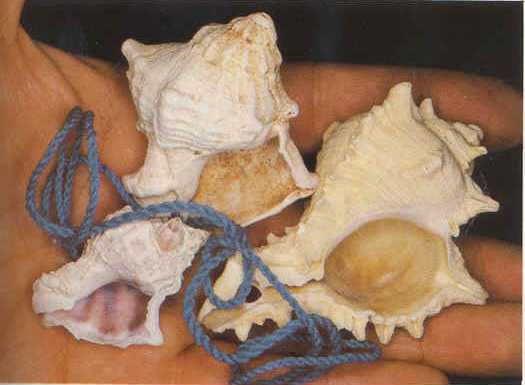 |
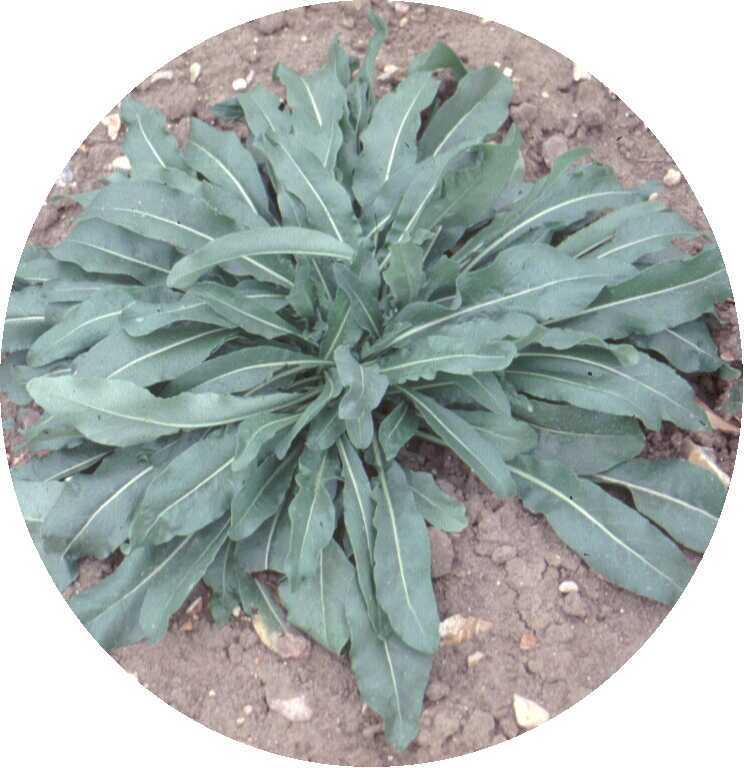 |
| Fig. 18 from 5. The Murex trunculus dried and Tekhelet thread from it. Photo: David Darom | Fig. 22. Woad, the indigoid plant. Photo: K.G.Gilbert, Ph.D., University of Bristol. |
Recently we learned from Rav Shabtai Rappoport that a new way to obtain blue color from Murex has been discovered.One can just treat dyed wool with hot water vapor, and purple wil turn into blue. This works with some of Murex species, notable Murex trunculus, while others yield stable purple color. This difference is in good agreement at archeological sites, where different kinds of snails were kept separately. Prof. Ziderman currently investigates the chemistry of the phenomenon.
Strong sides of snail theory../../images/hist/tekhelet../../images/hist/tekhelet
The hypothesis that Tekhelet was produced from snails is in good agreement with many facts, some of which are:
1) Tekhelet was counterfeited with kala ilan, as the Talmud says.4 This is identified by Aruch as “indika”. This means that the plant indigo yielded a color virtually indistinguishable from Tekhelet. But, after photo-debromination of the Tyrian purple, indigo is also obtained. So the color may really be the same!
2) The process of coloring included “taima” 4, when a small portion of the solution was dropped on the cloth in order to test the dyeing properties. This may refer to the vat process: one cannot see the color until the dye is affected by air.
3) The Talmud informs us that some people carrying Tekhelet from Israeli town Luz to Babylon were in great danger11 because the “Eagle,” which presumably means the Roman authorities, found Tekhelet in their hands. The Romans and other rulers forbade the use of the Tyrian purple by laymen, which confirms the proximity of the two dyes.
4) There is a question why Tekhelet had been lost much earlier that the Purple. This can be smoothly explained by two reasons – the prohibition of its free use by the authorities and the use of the cheap plant indigo instead of the expensive snail for blue dyeing. Nobody except Jews have used snails for blue dyeing ever since cultivation of indigoid plants began in the Mediterranean countries. So the production of the purple continued, and Tekhelet was lost!
5) In the ancient Israeli dye plant shown in Fig. 8 above, small amounts of dye were found. Its chemical analysis, carried out by Prof. Koren12, showed a mixture of indigo and brominated indigo. A lot of empty snail shells were found, which were sometimes grouped by species.
6) Some sources draw a parallel between Tekhelet and the Tyrian purple10. One striking example suggesting a royal status of Tekhelet and thus linking it to the Tyrian purple is Ramban’s commentary to the Torah, , where he says: “Even today nobody dares to wear Tekhelet, except the king of nations ”.13 By Ramban’s times, Tekhelet had already been lost but the purple was still known, to be lost as late as in the 15th century. An alternative explanation is that Ramban refers to the plant indigo blue, which was also limited by authorities at his time.
7) Since most materials for the Tabernacle were taken from Egypt during the Exodus, Tekhelet should have been some material well known to the Egyptians. This is linked well to the Tyrian purple, which is found on mummies’ clothes.
Weak sides of snail theory../../images/hist/tekhelet../../images/hist/tekhelet
1) Not all characteristics of the animal called “Hilazon” are easily found in the snail. However, a quick glance into the Talmudic encyclopedia reveals that it is nearly impossible to meet all of the requirements, since they are somewhat contradictory. The encyclopedia volume appeared in 1991; it mentions only two attempts of Tekhelet revival. The most problematic requirements are “body similar to fish”, “its color is like sea” and “black blood”. The P'til Tekhelet foundation has its own explanations: “color is like seabed, not sea” etc.
2) The Talmud (Menahot )4 describes a test designed to distinguish between Tekhelet and the plant “kala ilan.” If both colors are identical to that of indigo, how can they be distinguished? A possible answer to this criticism is: the test shows that the right dye is of greater fastness. In one case, the Talmud advises to put wool in an alkaline mixture and see if the color goes away (“ifrid”); this does seem to be a test on fastness, and, since the snail yields a very fast dye, this appears to be in favor of the snail theory. It should be kept in mind that the fastness of the dye is known to depend on the process of dyeing and may actually be more affected by admixtures than by the choice between source animal species or the choice between the plant and the snail.
3) In this theory, Argaman and Tekhelet were both produced from virtually identical mollusks. But the Talmud does distinguish between Argamon and Hilazon (though one can argue that there are several kinds of snail fish, of which some are better for purple and some for blue, the Talmud associating the former with Argamon and the latter with Tekhelet).
Concluding remarks
We have several options to choose the agent for Tekhelet dyeing. Polemics between the schools is still hot but mostly of a good quality and to the soul of the matter. Yet in some cases the argument is a bit crude. It should be put an end to, and such epithets for Tekhelet as “hassidishe ”,”mitnagdishe”, “of Yeshiva University” ought to be dropped.
One must also keep in mind that some indications in the Talmud are an indispensable part of the bulk of the criteria while others may just be some advice on how to catch the Hilazon. If the criteria are limited to a fast blue dye originating from a sea animal, then many species may be fine. In principle, one may even think that all the mentioned theories are good! It is also possible that only a creature with a shell will do; then, we are still left with both the Murex and the Janthina.
But the main point is that all the progress in the field of Tekhelet revival, which is necessary for the right fulfillment of the tzitzit commandment, as well as for rebuilding of the Temple, has been made in a close contact between religion and science. The standard first set by the Radzyner Rebbe will certainly stand in future. A spectacular case of good relations between the two domains!
Acknowledg ements
During the search of the sources, I made contact with many people; especially helpful were: Baruch Sterman, Ari Greenspan, Mendel Singer, John Edmonds, Zvi Koren, Joel Guberman, Saul Kaplan, Slomo Kolyakov, H.K. Mienis, I.I. Ziderman and many others. Dr. Asaf Kaniel found archive photos on Radzyn. Dimitry Sheinin greatly helped to improve language, style and contents. Great thanks!
Literature and Internet resources
1Exodus 26:1
2Exodus 28:5
3Numbers 16:38
4Tosefta Menahot 9, Gemara Menahot 43A, 44A (see pictures in R. Steinsalz edition), Megilla 6A, Bava Metzia 61B, Shabbat 75A, Sanhedrin 91A, Avoda Zara26B, Dvarim Rabba 7:11, ShirHaShirim Rabba 4:11.
5Rav Menachem Burshtin “HaTekhelet”
6“Hebrew porphyrology”, Ph. D. thesis of Rav Herzog in University of Dublin, 1914. See translation in 5. Encyclopedia Judaica describes the work as: "The Dyeing of Purple in Ancient Israel," 1919.
7 Ziderman I. I. Blue Thread of the Tzitzit - was the ancient dye a Prussian Blue or Tyrian Purple Journal of the Society of Dyers and Colourists, 1981, 97(8), pp. 362-364.../../images/hist/tekhelet../../images/hist/tekhelet
8
Elsner Otto, Spanier Ehud Dyeing with Murex
extracts, an unusual dyeing method of wool to the Biblical sky blue Proceedings of the
7th International Wool Textile Research Conference, Tokyo, 1985, 1985, 5, pp. 118-130.
The dyeing of wool with Tyrian purple to give tekhelet by a mollusk sex segregation method
and by the photochemical debromination method are discussed.
The color depends on mollusk's sex and the strength of light. ../../images/hist/tekhelet../../images/hist/tekhelet
9Edmonds J Tyrian or Imperial purple dye Historic Dye Series No 7,
ISBN 0 9534133 65, 2000, pp. 41pp.
Historic Dye Series No 7; Ancient vat dyeing was performed using biochemical reduction
analogous to that used in woad dyeing.
10 “P'til tekhelet” site on www.tekhelet.co.il/pub.htm. Former NDS employee Mois Navon is active there. Of great interest is polemics between R. M.Katz and Dr. M. Singer, Dr. B. Sterman. Counterarguments are found there and also on www.begedivri.com, www.chilazon.com.
11 Talmud Sanhedrin 12, see picture of Roman “eagle” in R. Steinsalz edition.../../images/hist/tekhelet../../images/hist/tekhelet
12 Koren Z C HPLC analysis of the natural scale insect, madder and
indigoid dyes Journal of the Society of Dyers and Colourists, 1994, 110, pp.
273-277.
A linear gradient elution method applied to dyes which are found on ancient textiles,
including indigotin, its mono- and di-brominated compounds, and indirubin and a previously
undetected component from Murex trunculus, tentatively identified as a dibromoindirubin.../../images/hist/tekhelet../../images/hist/tekhelet
13Ramban in commentary to Exodus 28:2../../images/hist/tekhelet../../images/hist/tekhelet
14Rav Eliyahu Tavger “Three articles on issue of Tekhelt”, P'til Tekhelet foundation edition, in Hebrew, 5757 year ( 1996)../../images/hist/tekhelet../../images/hist/tekhelet
15http://www.realtekhelet.com/ Site of Dr. S. W. Caplan
16A Nikki Padden, Vivian M Dillon, John Edmonds, M David Collins, Nerea Alvarez and Philip John, International Journal of Systematic Bacteriology 1999 49 1025-1031 An indigo-reducing moderate thermophile from a woad vat, Clostridium isatidis sp. nov. “Thermophile” means bacteria preferring hot environment.../../images/hist/tekhelet../../images/hist/tekhelet ../../images/hist/tekhelet../../images/hist/tekhelet
17Padden, A.N., John, P., Collins, M.D., Hutson, R. & Hall, A.R. Journal
of Archaeological Science. 2000 27 953-956
Indigo-reducing Clostridium isatidis isolated from a variety of sources, including a tenth
century Viking woad vat. ../../images/hist/tekhelet../../images/hist/tekhelet
18Koren Z C "The First Optimal All-Murex All-Natural Purple Dyeing in the Eastern Mediterranean in a Millennium and a Half", Journal of Dyes in History and Archaeology, 2003, in press.
19Monfils,
Paul "Purple Passion," American Conchologist 29(4):xx-xy, 2001;
Quarterly Journal of the Conchologists of America, Inc., New York../../images/hist/tekhelet../../images/hist/tekhelet
20Lacaze-Duthiers H Mйmoire sur le Pourpre Annales des Sciences Naturelles comprenant la Zoologie, la Botanique, 1859, 4th series, 12, pp. 5-84.../../images/hist/tekhelet../../images/hist/tekhelet
21Comfort, 1961. J. Mar. Biol. Ass. U.K., 41: 313-318../../images/hist/tekhelet../../images/hist/tekhelet
22Kennedy, 1979. Advances in Marine Biology, 16: 309-381. Pigments of Marine Invertebrates.
23Driessen, L. A. 1944 ‘Uber eine charakteristische Reaction des antiken Purpurs auf der Faser’, Melliand Textilberichte 26:66.

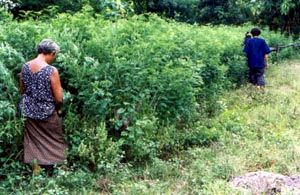 ../../images/hist/tekhelet
../../images/hist/tekhelet